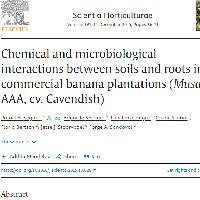Resumen
- A study was performed to determine the relationships between soil chemical and microbiological conditions and how they impact soil production. The study was carried out on six Costa Rican commercial banana farms with high, medium and low productivity. In each of the farms sector with relatively good and poor crop development were identified. In these sectors, microbiological and chemical properties of the soil and banana roots were characterized in the fertilization band, the interrow, and the rhizosphere. In addition, crop performance was evaluated in terms of plant height, the vigour of the pseudostem, and the number of hands per bunch. Higher biometric values were found in the sectors with good development, regardless of the farm, than in those with poor plant development. The pH was significantly lower in the sectors with poor crop performance in both the fertilization band and the rhizosphere. The soil chemical and microbiological properties differed significantly between the good and poor performing areas, but also between the fertilization band, interrow, and rhizosphere. Bacteria, fungi and actinomycetes were less in roots from plants in the sectors with poor performance. Chemical and microbiological conditions in the soil influenced the roots conditions according with the banana plant development and production. This study shows the complex interactions between soil chemical and microbiological conditions and how they affect banana production.
